Abstract
In recent years, three sections (Humipedon, Copedon and Lithopedon) were recognized in the soil profile. It was then possible to link the first and most biologically active section to the characteristics of the environment and soil genesis. In particular, it is now possible to distinguish organic horizons, mainly produced by arthropods and enchytraeids in cold and acidic or dry and arid environments, from organo-mineral horizons produced by earthworms in more temperate and mesotrophic environments. Each set of horizons can be associated with a humus system or form, with important implications for forestry. Anecic/endogeic earthworms and Mull or Amphi systems are more abundant in the early and late stages of sylvogenesis; by completely recycling litter, earthworms accelerate the availability of organic and inorganic soil nutrients to roots and pedofauna. On the other hand, arthropods and Moder or Tangel systems characterize the intermediate stages of sylvogenesis, where thickening in the organic horizons and the parallel impoverishment/reduction in the underlying organo-mineral horizons are observed. Recognizing the humus system at the right spatial and temporal scale is crucial for the biological management of a forest. This article includes a data review, new data from a doctoral thesis, and recent comparisons of Italian and French investigations.
Keywords:
humus; Humipedon; forest soil; forest dynamics; soil biodiversity; soil functioning; spruce forest 1. Introduction
The purpose of this work is to provide practical information to forest managers that can be used to correctly interpret soil quality for silvicultural purposes. For this reason, it was divided into the following four sections and a conclusion:
- (1)
- What is soil, and what, in particular, is forest soil?
- (2)
- Soil classification
- (3)
- The Humipedon in mountain and high-mountain forest environments
- Bipolar Amphi
- -
- Bipolar Amphi generated by the destruction of Mull humus
- -
- Bipolar Amphi generated by the destruction of Raw humus
- Forms of stable Amphi humus
- (4)
- Humipedon and forest management
- (5)
- Conclusions
The first two sections state some fundamental concepts that can be skipped by specialists who wish to start at the heart of the subject. In the third section, the topic is attacked operationally by identifying two sets of Humipedons that allow the reader to understand the natural dynamics of forest topsoil. After stating the elements of Humipedon classification, the fourth section mainly reports the results of a doctoral thesis. In it, the quality of Humipedon is investigated in targeted climatic and geological situations and at different stages of development in an alpine spruce forest. All readers can quickly find the main results for the finalized content of this thesis in the Graphical Abstract.
A reader who prefers images to text can understand the essential content of this article by reviewing the figures and their legends.
Although focused on spruce forests, this review should encourage readers to observe/study Humipedon in the forests they know or work in to better understand how these ecosystems use the ground to live and renew themselves.
2. What Is Soil, and What, in Particular, Is Forest Soil?
It is not easy to define what soil is [1,2,3,4]. Various aspects of this “object” still elude science [5]. In a functional context, we can say that soil is the “belly” of our planet Earth [6]. In fact, soil “digests” everything that falls on it and permanently recycles and stores everything. It is not yet clear how or what all the structures recycled over time become in detail, but the outcomes of this incessant digestion certainly support the natural evolution of the entire planet [7].
In the case of forests, a short focus can help to define what forest soil is from a descriptive and functional point of view and provide indications related to the needs of proper forest management [8].
From a physical point of view, in a forest, we walk on the ground: a “pabulum” (literally, “absorbable food”) that soil scientists divide into “horizons”. The following are clearly identifiable in the topsoil or Humipedon: organic horizons (of almost intact litter: OL; of fragmented litter: OF; of litter transformed into humus: OH; organic remains in water, almost intact: HF; half decomposed: HM; well decomposed: HS) and organo-mineral horizons (A from earthworms, A from arthropods, A non-zoogenic). Horizons that are very commonly used to describe other underlying parts of the soil include Copedon horizons (mineral, depleted: E; mineral newly formed: B) and Lithopedon (fragmented rock: C; compact rock: R).
Soil horizons are the result of an interaction between the geo-climatic environment in a geographical area on Earth and the organisms that are more or less permanently present in that volume of the biosphere (Figure 1). Many of these organisms complete their life cycle only in this component of the ecosystem. Although they belong to the same forest ecosystem, topsoil and soil have very different but complementary functions. They cannot exist without each other until the limit of their reserves is exhausted.
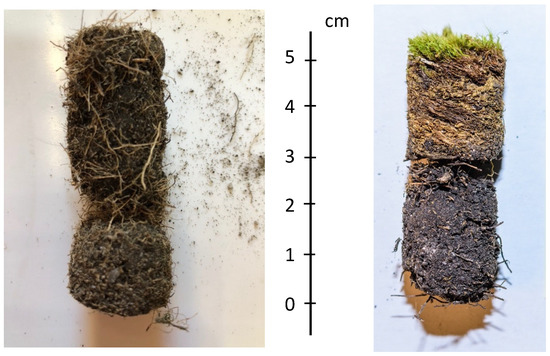
Figure 1.
Initial soils on acidic (Left) and calcareous (Right) ledges sampled by two student mountaineers [9,10]. The centimeter scale bar shown in the center applies to both images. These profiles were obtained from vertical rock faces at an altitude of about 2000 m by driving a tube into the ground supported with ledges 50–150 cm wide. In the photo on the left, we can see the organic part matted with roots (OH), which is detached from the slightly lighter organo-mineral part (A) and resting on the rock; on the right, detachment occurs between a light brown organic part made of decomposing moss (OF) and a darker organic part in contact with the rock (OH). These micro-soils rested on a fragmented rock horizon that was not picked up with the probe (C horizon). These profiles illustrate the early stages of soil formation in an untouched, high-altitude environment. The diagnostic horizons are composed of arthropods and enchytraeids excrements, grains of fragmented rock and shredded and decomposed organic matter, owing to the action of bacteria and fungi.
The biological characteristics primarily concern biodiversity, which, in the soil, is clearly different from that out of the soil due to the lower presence of autotrophs and the dominance of a more complex network of heterotrophs. In terms of the number and variety of species and individuals, the soil biodiversity is richer than that outside of the soil [11,12,13,14].
Then, the storage function becomes important. Soil is the “living bank” of the forest system [15]. It receives energy and matter from the outside and packages it in storage and release structures that are sensitive to biological stimuli. It looks like a “living sponge” placed on the rock. It can be several meters thick under particularly favorable conditions. At our latitudes, the thickness of the soil is less than 100 cm. The seeds of most forest plants lie dormant in the soil. When environmental conditions are appropriate, which, depending on scale, can correspond to a stand-replacing disturbance (e.g., wind storm avalanche, fire, etc.) as well as to a gap creation (e.g., fall of individual old trees), the activities of soil’s trophic network trigger the cessation of seed dormancy, and these seeds start the first dynamic phases of the forest ecosystem [16,17].
Finally, in soil genesis, Humipedon oversees the renewal and continuous growth of the forest ecosystem. In order to resist wear and tear and maintain an effective action over time, living organisms must undergo constant recycling. In a forest composed of complex and interconnected uni- and multicellular organisms, the natural death of these organisms involves the recycling of significant quantities of components that are transformed into the soil. This recycling takes place in two stages: decomposition of the original structures and composition of new structures ready for reuse inside and outside of the ground. The point is that both organic and mineral materials are concerned with the dichotomy between building and reuse fractions (also called inherited and newly formed). The inherited part of the soil is issued from dislocation, while the newly formed part of the soil generates fundamental materials such as clays and humic acids. The two opposing movements end at a point that is still not fully known today. This unknown is expressed in the word “humus”, which has a transcendental meaning that always stimulated scientists. A milestone in this scientific journey is certainly the study by Miller and Urey [18]. They placed the molecules of a primitive soil soup in a test tube and, imitating the environment of a planet in its infancy, they attempted to create the first bricks of the living world. Using artificial electrical discharges mimicking distant storms, that primitive matrix produced many of the molecules that make up living cells.
It should be emphasized that soil is not a habitat. There is no “home for living organisms” called “soil” because soil microorganisms “are soil”. An example of a soil habitat could be that of the moon as it does not contain microorganisms [19]. A “soil-habitat” can be made on our planet by sterilizing ordinary soil using autoclaving at 105 °C for 48 h. However, the problem is that once sterilized, it will no longer be soil. Soil made up of organo-mineral aggregates containing microorganisms looks more like a giant amoeba than an inert rock. It is certain that soil corresponds to an ecosystem [20], but to come to consider the soil as if it possessed the functional complexity of a supra-organism is still an open discussion [21].
The present article is based on a purely living soil definition. Some of the authors strongly disagree with a purely biological definition for the concept of soil, but we mutually agreed to keep it in this article to provoke discussion and growth. Thus, we focus on a fundamental issue that cannot remain unresolved: the soil is either a biological matrix and, therefore, it must be treated as such (it must be protected as an inherited living structure) or it is a raw material inhabited by living beings and, therefore, we can destroy and modify it (for example, with the plow or by occupying it without thinking that we are destroying something irrecoverable) as if it were not an entity with a valuable historical path and heritage.
To conclude this introduction to the concept of soil, we now discuss earthworms, which are the main “builders” of soil on our planet, at least in all areas between −5 and +35 °C [22,23]. Trying to summarize their action in a few lines is difficult. Therefore, we recommend downloading for free the fantastic book by Clive A. Edwards and Norman Q. Arancon [24], in which historical research on earthworms is collected, and reviewing the appropriate information. This book takes the reader very far and on the same path traced by Darwin in 1881 [25], in search of the functional and ecological significance of these underground animals.
3. Soil Classification
In general, to better understand and correctly use the components of nature, it is necessary to determine their classification. In the case of pedology, the fact that the conceptual difference between “soil-living-system” and “habitat” was fundamental has complicated the work of soil classification.
Historically, forest pedologists focused their research on describing and classifying natural or semi-natural soils that have not been manipulated by programmed human practices (unplowed). These soils show a vertical stratification (presence of horizons) because the addition of litter on the surface and the alteration of the bottom bedrock have contrasting effects on the soil profile. The mechanism underlying the biological integration of litter into the rest of the profile (first 30 cm) was described, distinguishing different degrees of biodegradation in this litter, which remains whole on the surface and then fragments until it becomes “humus” in contact with soil minerals [26]. The foresters found that these surface horizons varied according to the climate and biocenosis that incorporated the litter into the soil. Somewhat confusingly, one or all the surface horizons in forest soil were called “forest humus”. Today, these surface horizons are classified into humus systems and forms.
Agronomists classified soils that were generally plowed to grow crops and produce food [27]. Periodically, the uppermost horizons in these soils were mechanically mixed with the underlying horizons to form a more effective matrix for cultivation. Thus, the artificial stratification at the surface was added to the deeper natural stratification. Agronomists were mainly interested in the chemical and physical properties of what they considered to be a growing substrate. Soil samples from the plowed layer (first 30–40 cm) could be obtained before and after cultivation and analyzed in order to balance and replenish the soil with fertilizers that cultivation had removed in the form of mineral elements. The living beings in the agricultural land were defined as useful, indifferent, or harmful according to their repercussions on production.
In the mineral horizons developing below the first 10–40 (just described), the biological aspects are less important and their composition and structure change less rapidly with time. Their chemical and physical characteristics (e.g., thickness, texture, pH, color) were divided into classes, as defined by the historical experience of specialists, and then related to each other to describe diagnostic horizons. Specific sets of diagnostic horizons were assigned to groups of reference soils with names (reference soil groups). Adjectives (qualifiers) were also used to improve the definition of the unit to which the observed profile belonged. The American school also considered climate [28,29], and the Russian school gave weight to vegetation [30]; however, for more than 30 years, the ecological and biological aspects of soil formation and dynamics were ignored in the volumes of the WRB for soil [31]. Luckily, a beautifully illustrated version of the WRB soil classification was recently published. In it, the planet’s soils are finally represented within phyto-climatic bands [32].
In daily practice, scientists who need to know the name of a specific soil (some journals require the use of soil names) ask soil specialists to intervene. These specialists analyze the profile and provide a name. The information contained in the name of the soil is either difficult for the user to access or has a descriptive and impractical interest. By working on the balance of nutrients and organic carbon, or on the possible presence of a clayey and impermeable horizon at depth, agronomists and foresters are able to manage soil without the need for classification. Unfortunately, this has serious consequences. For example, agricultural soils have lost 80% of the organic matter they contained 50 years ago [33,34,35]. Organic matter is related to the energy stored in the soil and the water-holding capacity of the soil. We know that the loss of organic matter is due to a sudden decrease in biodiversity (related to the use of herbicides and pesticides [36,37]), which is a consequence of the little importance that has been given to this component in the diagnosis of soil quality [38].
Errors in the selection of forest plant species are often related to the fact that the soil is considered a product of the vegetation rather than a complex component of the forest ecosystem whose dynamics both depend on and influence the ecosystem’s equilibrium state [39,40].
Recently, in an attempt to clarify and better understand the functioning of the forest floor [41], the “ecosystem-soil” (in the sense of [42,43,44,45]) was divided into three sections, functionally grouping the horizons as follows [6]: Humipedon (organic and organo-mineral horizons with biological determinant: O and A), Copedon (mineral horizons of recent formation: E, B) and Lithopedon (rock mineral horizons: C, R).
In the Humipedon, most of the biological activities of the soil take place because they are strongly dependent on the input of energy that comes in the form of organic molecules from the vegetable topsoil.
The Lithopedon is the deepest part of the soil, which is in contact with a rock that is transformed. In the Lithopedon, there are mineral blocks that disaggregate and contribute to feeding a flow of water and nutrients that circulate in the soil by gravity, capillarity, and biological ascent. In the central part, or Copedon, chemical–physical and biological processes take place that transform this boundary mass between the organic and mineral layers into something new (neo-clays, hydroxides, etc.) and suitable for composing the living sponge that is the soil as a whole.
The classification of Humipedon (Figure 2) is both biological and morpho-functional. It is based on the principle that the diagnostic horizons that make it up are the result of biological activities visible to the naked eye in the field. Specific series of these horizons define humus systems that develop in ecologically limited natural environments. The relative thicknesses of the diagnostic horizons define the humus forms within each humus system.
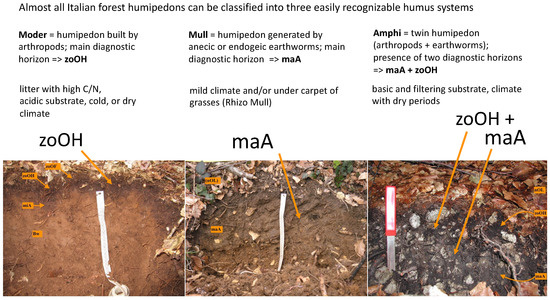
Figure 2.
Italian forest Humipedons are mainly attributed to three humus systems: Mull (from earthworms), Moder (from arthropods) and Amphi (from earthworms and arthropods). The latter was first recognized by Franz Hartman 50 years ago. He called it twin humus. In 1995, the French considered it as a strange Mull and named it Amphimull. By 2018, it regained full recognition as a fundamental unit of classification, with the definitive name of Amphi (=double, twin). With this humus system, it is much easier to understand the short-term dynamics (years, decades) of soil linked to the dynamics of the forest and its structural types.
Copedon corresponds to the E and B horizons in soil classification. It is not yet classified as a biological ecosystem soil.
The classification of Lithopedon reconsiders the whole of the C horizon and the R substrate of the soil, proposing units related to the functioning of such deep parts of the soil [46].
The Humipedon is studied in more detail than the whole soil because foresters and agronomists know that it is very important for the biological and dynamic aspects of soil. Although it does not appear in the international soil classifications cited above, more recent emphasis has been placed on soil biology to improve the agricultural use of Humipedon. The sustainable agriculture policy (which is part of the very recent European agricultural development plan) considers and promotes Humipedon using studies on the biological quality of soil carried out separately and equally well for arthropods and earthworms [47,48,49,50]. Fortunately, these practices are tending to spread and establish themselves internationally, superseding areas that were dedicated to intensive agriculture [51,52,53]. Among other things, attempts are made to imitate nature by reducing the work of the soil on the surface, respecting the natural biological stratification of the soil [54,55,56,57], and recovering the biodiversity and organic matter that was lost.
Foresters, on the other hand, improve the description of the superficial diagnostic horizons and consolidate references to the different environments in which soils are generated. The overall picture is very well organized, with precise links to the understanding of soil functionality, taking under consideration the carbon cycle, the dynamics of mineral elements and litter, the relationships with natural topsoil renewal and soil changes in the structural phases of the forests [58].
4. The Humipedon in Mountain and High-Mountain Forest Environments
The strength of the interactions within a couple can be tested at their limits. This is as true for the interactions between two human beings as it is for the interactions between vegetation and humus. Ponge et al. [59] postulate that at the low-montane level, forest regeneration is limited most of the time by light alone because humus metabolism is always high; in contrast, at the high-mountain level, light becomes less and less of a limiting factor and humus becomes thicker. As a consequence, the role of burrowing animals such as earthworms in ecosystem functioning changes from important to critical as the transition from mountain to subalpine forest occurs. Earthworm burrowing activity alters humus on two levels. Macroscopically, the large anecic earthworms are able to modify their environment by spreading their organo-mineral feces along their main middens and secondary exploratory tunnels. Microscopically, earthworms ingest both organic and mineral material, mixing the two thoroughly. The result of their activity is thus the formation of the organo-mineral complex [60,61,62]. As a result of the increasing rate of organo-mineral complexes near the surface, tree seeds can easily find a favorable microsite to grow. André et al. [63] show that a key component in forest regeneration is the occurrence of mineral substance near the surface (Figure 3). In an experimental plot in Savoy, almost all very young spruce trees were found to be growing on mineral deposits created with the burrowing activity of small mammals compared to the undisturbed soil [64]. This regeneration micro-niche could be experimentally replicated by stripping the holorganic part of the humus.
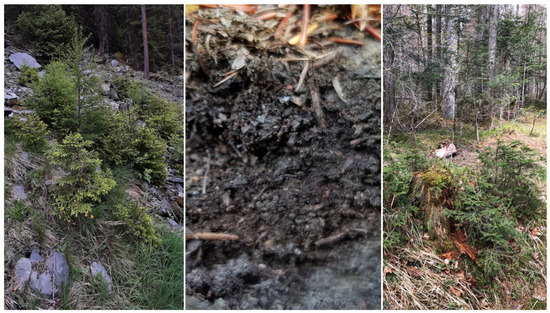
Figure 3.
Examples showing subalpine forest regeneration sites on a scree slope. (Left): on weakly stabilized skeletal soil. (Center): the few-centimeters-thin A horizon of a Mull system on skeletal soil on and between blocks of rock in Grand Follié forest—1550 m, Saint Foy Tarentaise, France. (Right): on a stump, i.e., an example of a 50 cm thick Ligno humus form (Somadida forest—1300 m, Auronzo, Italy).
In the subalpine belt, there are many reasons why minerals come close to the surface. The most effective is indeed the burrowing of earthworms (Figure 4 and Figure 5, in Section 4.1), but it can also be the consequence of other biological activities as diverse as wild boars [65], tree uprooting [66,67], millipede activity [68], small mammals [69] and human digging of forest roads [65,70]. It can also have a physicochemical origin, such as an alteration to the bedrock of a small overhanging cliff and the subsequent debris on steep slopes. All these are drivers of humus form change, leading to a mineral enrichment near the surface that supports forest regeneration. However, such mineral input in a holorganic humus form is often discontinuous in space and time, or, if bioturbation is generalized, it is present at low levels in subalpine forests [71]. In contrast to lowland forest bioturbation, which produces the Mull humus form, low-level and/or episodic bioturbation in mountain environments produces a range of Amphi humus forms.
The four Amphi humus forms (Leptoamphi, Eumacroamphi, Eumesoamphi, Pachyamphi), identified in the Amphi humus system using the thickness of the OH horizon and the structure of the A horizon [6], can be grouped into two main functional categories. The Bipolar Amphi forms evolve continuously between the Mull and Moder or Tangel humus forms, sometimes in the direction of Mull and sometimes in the direction of Moder or Tangel. They are characterized by the perturbation of large earthworms, which release their biomacrostructured organo-mineral excrements into the organic layers, orienting the evolution in two opposite directions: toward Mull (Leptoamphi) when the excrements increase and toward Moder when instead they decrease (Eumacroamphi, with thicker OH). The Stable Amphi forms are stable intermediates between Moder or Tangel and Mull, reflecting an incomplete but homogeneous organo-mineral incorporation. They generate a holorganic horizon above (OH) and a biomesostructured or a mixed biomeso- and biomicrostructured organo-mineral horizon (meA) below (Eumesoamphi, or Pachyamphi with thicker OH).
In general, with an increase in altitude, the Humipedon passes from Mull to Moder and finally to Mor (rare in a forest environment on the Italian side of the Alps) on an acidic substrate, while it passes from Mull to Amphi and then to Tangel on a calcareous or dolomitic substrate. The difference between a very thick Dysmoder and a Mor or a Tangel is a specialist topic and requires knowledge related to soil fauna. To simplify presenting the dynamics of the Amphi in the following paragraphs, we prefer to use the name Raw humus for Moder, Mor and Tangel, in which anecic earthworm bioturbation is absent. We can say in a simplified way that we progressively pass from Mull to Raw humus with a rise in altitude due to a decrease in the biological activity of the soil. This dynamic is important for understanding how forest soil works. Below we propose a practical simplification that could facilitate an understanding of Humipedon in a mountain forest environment even for beginners.
4.1. Bipolar Amphi
4.1.1. Bipolar Amphi Generated with the Destruction of Mull Humus
As Mull activity weakens, the first stage of Amphi is characterized by a more or less continuous OH horizon, depending on the drastic or progressive collapse of earthworm activity, overlaying a well-developed A horizon (Figure 4). As the bioturbation of Mull humus weakens, the humus develops an OH horizon with a sharp transition to the underlying A horizon. Initially, the OH layer is thin or in pockets and the A horizon is well preserved, so the humus form is a Leptoamphi. As time passes and the burrowing activity decreases, the OH layer develops, the A horizon loses its structure and the humus becomes an Eumacroamphi. Such Amphi humus forms are particularly observed under young spruce when mull-forming factors such as large anecic earthworm activity collapse [72] (Figure 5, Left, Section 4.1.2).
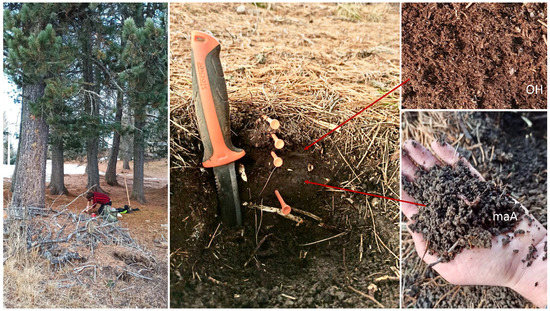
Figure 4.
Example showing Bipolar Amphi. Below this nucleus of Pinus cembra, a simple and stratified structure of the Humipedon can be clearly seen, with relatively thin organic OL and OF horizons on the surface resting on a dark and organic OH horizon. The Humpideon distinguishes itself from the underlying and lighter organo-mineral horizon A (on the pedologist’s hand), which is biomacrostructured by earthworms. Monte Penegal, Trentino, the Alps, Italy.
4.1.2. Bipolar Amphi Generated with the Destruction of Raw Humus
The recent burrowing activity of a new earthworm community, in a raw humus context (often a thick Dysmoder), drives the humus profile to drastic changes (Figure 5, Center and Right). Earthworms nourish the entire humus profile with sparse but substantial dropping activity (from the OL layer to the A/C soil horizon to the OH layer) (Figure 4, Center and Right). Both the dispersal of organo-mineral feces and the depletion in OL horizon material cause the bipolar Amphi to exhibit some new features within the OL, OF and OH horizons. Early in the process, the A horizon is nearly absent, and then biomacrostructured organo-mineral complexes of anecic worms are distributed along the OL, OF and OH horizons. Over time, the A horizon develops and the OH horizon becomes discontinuous and relict (Figure 5, Right). The soil under old trees hosts a new population of earthworms as the trees age and prepare for their replacement [72].
Notice that these Bipolar Amphi (Section 4.1.1 and Section 4.1.2), generated from the destruction of Mull or Raw humus, are not symmetrical. The first is characterized by the establishment of stratification with a sharp transition between horizons. The second instead shows the transformation of each humus horizon due to the stochastic deposition of new earthworm casts. This phenomenon could be interpreted as a hysteresis process related to the long-term life cycle of a forest ecosystem exposed to a harsh climate. Such Bipolar Amphi humus forms may qualitatively and quantitatively deviate from the range of thickness and compositional variations established in the current humus classification systems [6]. In these environments, and connected to forest dynamics, the principle of coexistence typical of the Amphi undergoes a vertical disruption: one of the two systems is no longer above the other, but they coexist patchily, leading to the mixed cohabitation of OH and A horizons that characterizes Bipolar Amphi. We recommend recording these new mixed horizons as AOH or OHA, depending on the dominance of the first or second component of the mixture.
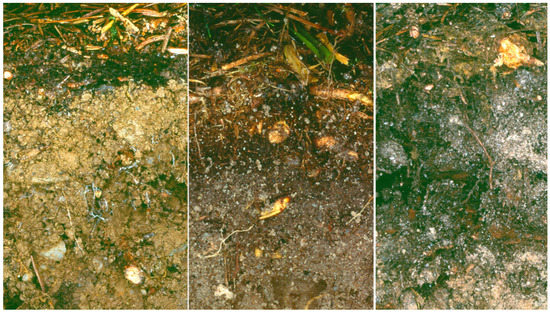
Figure 5.
Bipolar Amphi humus form. (Left): Bipolar Amphi (destruction of a Mull, starting process) under a young regeneration spruce tree with three distinctly separated horizons: OL, OF lying above a dark discontinuous organic OH and deposited above a well-developed gray glomerular A (Mâcot-la-Plagne forest, 1550 m, France). (Center): Bipolar Amphi (destruction of Raw humus) under an old larch tree showing the dropping of organo-mineral earthworm casts along the profile, which disturbed the structure and destroyed the clearly separated horizons in the former Dysmoder (Mâcot-la-Plagne forest, 1550 m, France). (Right): Bipolar Amphi (destruction of Raw humus) under an old spruce tree showing advanced destructuration of the OF and OH horizons with the inclusion of earthworm organo-mineral casts (Mâcot-la-Plagne forest, 1750 m, France).
4.2. Stable Amphi Humus Forms
Stable Amphi is either a real intermediate humus form or the superposition of the two humus forms. In the first case, as a real intermediate between Raw and Mull humus, the drastic transformation of the pre-existing OF and OH layers (or A horizon) into a mixed OHA horizon reflects an incomplete but well-distributed organo-mineral incorporation (Figure 6). In these Amphi forms, the bioturbation force is continuous but at a low level; it does not completely mask the stratified organization of the Raw humus form (organic horizons are still in place) as it occurs in Mull systems, where holorganic horizons are absent. The result is a thick OHA humus horizon, i.e., an OH horizon containing a substantial fraction of minerals. In Stable Amphi, the bioturbation force is often weaker than in Bipolar Amphi. In contrast to Bipolar Amphi, which are generally biomacrosructured (composed of large aggregates with a diameter >4 mm), Stable Amphi show biomesostructured (1 mm < aggregates ≤ 4 mm) or even biomicro (aggregates ≤ 1 mm) A or OHA horizons since the forces of bioturbation depend on tiny organisms such as enchytraeids, small epigeic earthworms, diplopods or simply passive mineral input during weak but persistent landslides. The weakening of bioturbation forces is generally associated with harsh climates (cold mountain and subalpine forests and seasonally dry and warm submontane forests) [71,73]. Amphi humus with an A horizon endowed with biomeso- and biomicrostructured A or OHA horizons has also been observed in Mediterranean environments [74,75]. We think that in these environments, the low temperature would not be a limiting factor, but periodic droughts might have an effect.
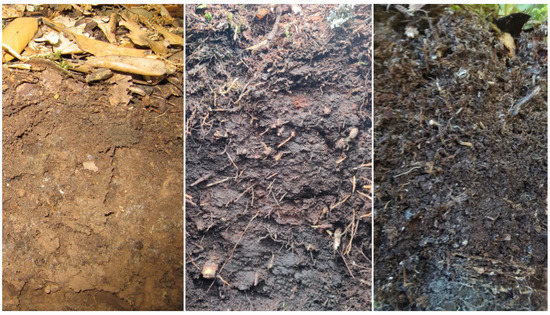
Figure 6.
The Stable Amphi humus. (Left): The Amphi of a holm oak forest in Sardinia compared with equivalent Alpine Amphi. (Center): Amphi under a thin layer of red litter (larch needles, OL) composed of a reddish organic paste (OH horizon) mixed with large dark gray organo-mineral aggregates (A horizon) whose volume increases with depth (Val Tellina at 1800 m, Italy). (Right): Amphi restricted to the newly created OH/A layer, composed of an intimate mixture of holorganic brown droppings (OH, brown; more visible because it is less mixed towards the surface) and organo-mineral feces (A horizon) of small size (probably from small earthworms and enchytraeids), which are barely distinguishable (they are a little grayer and more compact toward the middle of the photograph) and become more mineral and grayer toward the bottom (Grand Follié forest, Sainte-Foy-Tarentaise, France).
In some very specific cases, we can observe the cohabitation of endogeic fauna with an epigeic fauna. The resulting humus profile is twofold. On the one hand, there is the typical sequence of layers, i.e., OL, OF and OH, inherited from the Moder form. On the other hand, there is a biomacrostructured A horizon similar to a Mull form. Both cases have very few interactions, leading to a stable and stratified Amphi humus form [76] (Figure 6).
Forest regeneration is the main driver of the Bipolar Amphi system, limiting the duration and the extent of Mull humus to old-growth eco-units and clearings [72]. This does not mean that Bipolar Amphi has nothing to do with climate, although it is possible to find a similar limitation in lowland forests [77]. However, the regeneration niche does not exactly coincide with the Mull or Amphi systems because of the beneficial role of decayed wood [78]. At the subalpine level, decayed wood is the main regeneration niche when mineral bioturbation is not possible [79]. However, decayed wood is not always visible as a large stump, log or trunk (Figure 6). More than half of the decayed wood is invisible at first sight because it has been incorporated into the humus profile over time [80] or because it comes from the decomposition of dead roots (Figure 7). As an analogy to Mull and forest regeneration relationships in the mountain zone, Ligno humus systems [81,82] are important for lowland and mountain forest regeneration and crucial in the subalpine zone. This is because real Mull and Amphi humus forms are rare, and the humus dynamic process is less and less efficient at activating bioturbation in preexisting Raw humus forms. Therefore, decayed wood is the last option for forest regeneration and becomes a key component in forest stability near the upper-forest limit [83].
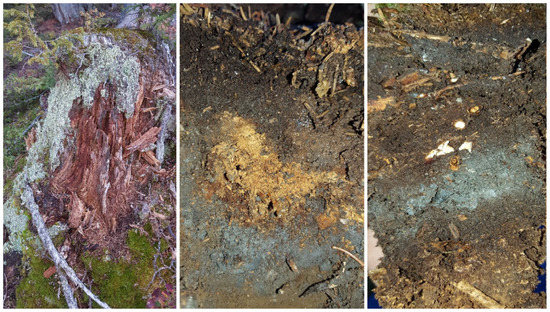
Figure 7.
Examples of Ligno humus forms from Grand Follié forest, Sainte-Foy-Tarentaise, France. (Left): a decaying stump with a young spruce tree in a pure wood humus form. (Center): a Ligno Dysmoder with a deeply sunk ligno layer, probably derived from a large decaying root. (Right): a complex Ligno Amphi humus form. Basically, such a profile corresponds to ancient Dysmoder or Mor humus forms that underwent two periods of mineral enrichment: the deeper half-buried one, probably generated from a landslide, and the second just below the OF layer, probably the fruit of biological enrichment. The whole profile develops over a decaying woody layer (Grand Follié forest, Sainte-Foy-Tarentaise, France).
The photographs in Figure 7 and Figure 8 and the schematic representation in Figure 9 show how the wood in the forest is integrated into the soil, which becomes a resource for the future of the forest, considering, for example, the context of an Amphi system.
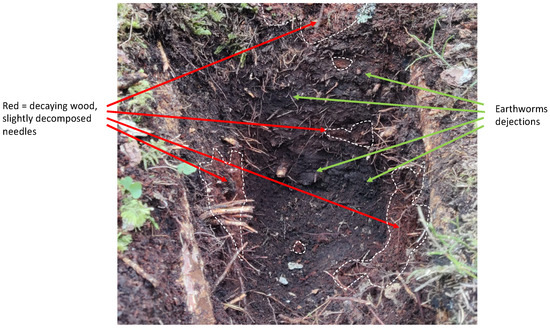
Figure 8.
Bipolar Amphi are common in spruce woods and show reddish layers of woody horizons; the deeper they are, the more they are decomposed. When the A horizon becomes dominant, the forest is ready for regeneration. Somadida forest, Belluno, Italy.
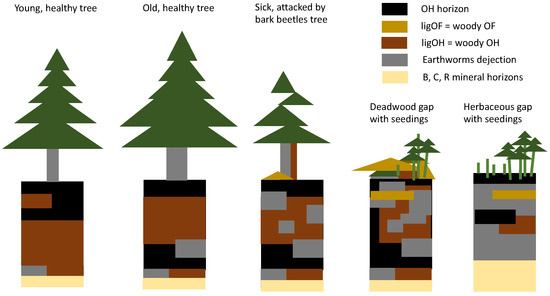
Figure 9.
Humipedon dynamics (Zangiacomo, unpublished scheme still under investigation). In the Italian Alps, the bark beetle is currently attacking the Somadida forest (Belluno). We are trying to understand what happens at the Humipedon level. Trees lose their crowns (in the center of the figure, the tree that has lost part of its crown), and large quantities of bark and dead wood accumulate on the ground, feeding the Humipedon. Given the important role of decomposing wood (ligOF and ligOH horizons [81,82]), the dynamics could also be understood as a transformation from a Ligno system toward Amphi, perhaps slowing down the process that goes from Raw humus to Bipolar Amphi (third and fourth profiles, from the left) or Mull (fifth and last profile on the right), mentioned above.
The death of the trees is not a loss to the forest; instead, the actual functioning of a forest ecosystem and its biodiversity is hindered by the lack of decaying wood [84]. Like all other organisms that die, decaying trees feed the soil, which returns this organic matter after having been transformed into building blocks for a new complex part of the forest. We are currently comparing the morphological characteristics of Humipedon found under trees attacked by spruce bark beetles and under healthy trees (Figure 9). As the forest opens up due to the loss of canopy cover, the Humipedon receives more light in addition to the dead organic matter. The above-mentioned change in the Humipedon is triggered by the arrival of earthworms, which cause the integration of organic matter into organo-mineral aggregates and the progressive disappearance of OH horizons. This phenomenon can be observed with the naked eye in the forest. With the arrival of bark and wood from dead trees, the conditions of Humipedon resemble those found near old stumps. These conditions are known to stimulate forest regeneration (Figure 9).
5. Humipedon and Forest Management
An imaginary horizontal surface located below the forester’s feet divides the forest into two distinct yet integrated and highly interacting components of the same ecosystem. In general, the aboveground component is better known because it is more accessible for surveys and measurements. This component transforms solar radiation into a more useful form of energy thanks to the photosynthetic process, from which the forester extracts a part of the biomass for the needs of the human economy. Under the forester’s feet, a second “biological forge” develops the Humipedon. This also corresponds to a living, functional and efficient ecosystem component that supports and cooperates with the one above, from which it in turn receives the energy and matter needed for its distinctive processes, in the form of necromass (leaves, needles, bark, wood, the transformed remains of animals).
Therefore, Humipedon has its own ecological pyramid at different levels. Among the most typical animals in this ecosystem component, earthworms play a particularly important role as they feed on necromass along with the mineral soil. In their guts, which are almost as long as their bodies, they digest leaves and extract energy and minerals required for their metabolism. During this digestion process, part of the resulting molecules ends up in circulation in the earthworm’s body, which provides the energy and matter required to complete its life cycle. The waste pulp expelled from the body of earthworms is what Darwin (Figure 10) discovered back in 1881 and called “soil” [25]. It helps us to imagine an elastic and living tube, which moves in the soil by ingesting leaves and earth and expelling “living-soil”. This phenomenon became even more interesting when Marcel Bouché discovered that earthworms also eat their own excrement [85]. It is not ingested fresh but only after the excrement has matured in the soil for a certain period of time. Earthworms can extract matter to live on from their own excrement, and during the process, they move the soil unceasingly, making it homogeneous. Undisturbed in the forest floor, year after year, earthworms increase the amount of carbon in the Humipedon and distribute it uniformly in the profile. Furthermore, their movement creates tunnels in which air and water can circulate, allowing the degradation of organic matter and the reproduction of organisms present in the depths. Thus, the Humipedon can be thought of as an “auto-recharging living battery” of the forest. The recycling of organic matter produced by the autotrophs on the surface depends on earthworms, which continuously recharge the Humipedon “organic battery” of the forest. On a small scale, the presence of innumerable microorganisms can explain the functioning of the entire ecosystem, which evolves almost autonomously, because it should contain all connected living things, including humans, whether they are forest operators or not (Figure 10) [86,87]. We now return to the concept of soil (Chapter 1): soil (and even more, its most living part, the Humipedon) should not be considered a “habitat”. Only the “new soil” that is “made by the living”, “the organo-mineral sorption complex, the living things that make it and maintain it, the connection network between livings that keeps this network alive” is soil. The rest can be considered habitat or substrate. Either the soil is alive, or it does not exist [88,89,90,91,92,93].
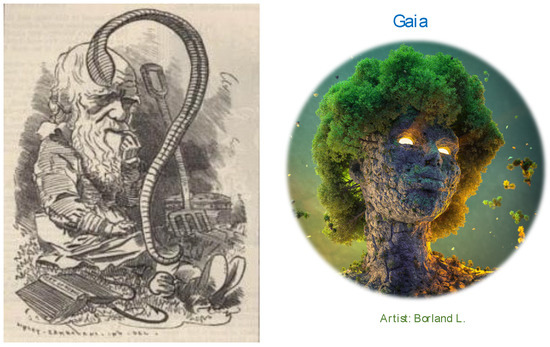
Figure 10.
(Left): Linley Sambourne’s satiric portrait of Darwin, published in Punch, 1881 (Punch’s funcy portraits n. 54: https://www.meisterdrucke.fr/fine-art-prints/Edward-Linley-Sambourne/1045006/Charles-Darwin-%281809-1882%29-Naturaliste-anglais.-L%27%C3%A9volution-par-la-s%C3%A9lection-naturelle.-Caricature-d%27Edward-Linley-Sambourne-%281844-1910%29-dans-la-s%C3%A9rie-Fancy-Portrait-de-Punch,-Londres-1881,-ann%C3%A9e-o%C3%B9-Darwin-a-publi%C3%A9-The-Formation-of-Vegetable-Mould-through-.html, accessed on 24 June 2023). Note that the earthworm was depicted as a question mark, with its flattened tail mimicking the head of a potentially dangerous cobra. (Right): James Lovelock’s Gaia is a scientific hypothesis only for blind scientists. We like to present Lokio Borland’s captivating depiction of Gaia (https://lokio.artstation.com/projects/zgxJD, accessed on 24 June 2023) alongside the historical and dubious, but still modern, Darwin.
Earthworms characterize Mull Humipedons, which develop in temperate, mild, warm and humid climatic environments, such as those found in the meadows described by Darwin, and in all the deciduous lowland forests in Europe. They do not have the OH (humiferous) horizon typical of colder or drier environments with conifers or xerophilous species. Other animals (enchytraeids and/or especially arthropods) are responsible for recharging the battery of the soil in these colder or even drier environments, such as the Mediterranean [94]. More generally, also considering wetlands, living organisms and the mechanisms for recharging and maintaining energy in the soil have evolved for each ecosystem environment (Figure 11).
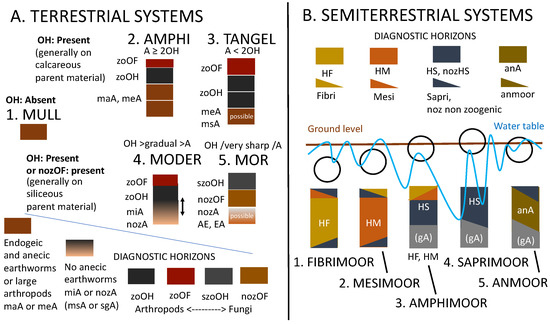
Figure 11.
Synthetic keys for the classification of Humipedons in reference humus systems for terrestrial environments (non-asphyxiated soils) or for semiterrestrial environments (more or less submerged soils, peats). Modified from Zanella et al. [6] with permission. These keys are based on the recognition of diagnostic horizons. The superimposed set of these horizons corresponds to a function of the Humipedon, in harmony with the rest of the soil, with the vegetation and climate of those environments. Summary legend: Horizons of Humipedon: Terrestrial (aerated) organic horizons: OL, OF, OH + organo-mineral horizons: A; Semiterrestrial (more or less submerged) organic horizons: HF, HM, HS + organo-mineral horizons: A. Meaning of lowercase letters applied as prefixes to diagnostic horizon codes: zo = zoogenic, noz = non-zoogenic, szo = weakly zoogenic, an = of Anmoor, ma = biomacrostructured, me = biomesostructured, mi = biomesostructured, ms = massive, sg = single-grain. Meaning of the initial part of the name of semiterrestrial systems: Fibri = generally submerged and very fibrous, Sapri = completely transformed into organic pulp, Mesi = transition between Fibri and Sapri, Moor = peats. About the relative thicknesses of the horizons and the accuracy of the transition between them: A ≥ 2 OH: thickness of the A horizon ≥ 2 times that of the OH; A < 2 OH: thickness of the horizon A < 2 times that of the OH; OH < gradual A: gradual transition between OH and A, inaccuracy > 5 mm; OH/net/A: sudden transition between OH and A, inaccuracy < 3 mm.
There are freely available iOS (https://apps.apple.com/us/app/terrhum/id1366575503, accessed on 24 June 2023) and Android (https://play.google.com/store/apps/details?id=fr.inra.terrhum&hl=en_US&gl=US, accessed on 24 June 2023) applications in Italian, French and English languages, for tablets and mobile phones. During field observations, these applications can provide quick and useful indications for classification and photographic examples of horizons, forms and systems of humus.
From what has been said, we must conclude that it is necessary to plan and practice specific management for forest soil. When you walk on the forest floor, your feet are resting on a very useful living sponge, which exists not only as a support for the static anchoring of trees, which play a dominant role as the driving force of the ecosystem, but also as a source of energy for all the whole forest life.
It is necessary to manage the soil, as already performed for the overlying tree part of the forest ecosystem, and to foresee a real plan for the conservation and restoration of the soil. This includes (i) an estimation of the average amount of organic carbon present in the soil in each management unit (above soil provision) and the structure and consistency of the eco-units (structural types in the sense of [95,96]); (ii) identifying the systems and forms of humus dominant in each eco-unit; and (iii) creating a list of functional groups of soil animals with the number of individuals in relation to seasonality [84].
It would be also of great interest to obtain a list of Humipedon living organisms, using sequencing of the soil metagenome (“Shotgun Metagenomic Sequencing”), to understand which functional groups of microorganisms are present in the soil and their relationships with topsoil plant species and with the other living organisms in the ecosystem [89,97,98].
It has long been known that vegetation structural types have their own Humipedon related to the age of the trees and the forest cycle [72,76,79]. A coordinated balance between the above and below ground is necessary for continuity in the forest cycle with a phase for consumption of soil resources in the young forest phase and replenishment and recapitalization of resources during the mature and final forest phases [99,100]. Knowing how to distinguish earthworm horizons from the others in Humipedon (Figure 2) allows us to check whether the evolution of Humipedon follows harmoniously that of the topsoil and to diagnose problems related to regeneration [101,102,103].
Figure 12 shows, as an example, the results of a doctoral thesis carried out in Trentino spruce forests [99]. It shows how the stages of forest development (herbaceous opening, natural regeneration, intermediate age, adult/mature forest) correspond to Humipedons classified in different humus systems. Such systems are shown schematically in Figure 12: Mull and Amphi (mainly Bipolar) humus are characterized by an A horizon formed by earthworms, which is not present in Moder or Mor humus. Basically, the forest floor evolves with the age of the trees it supports in balance with their needs. We consider that at the end of their life, trees prepare the soil for the next generation, feeding it and attracting the earthworms that prepare the organo-mineral aggregates that guarantee a good supply of water and nutrients to the new trees.
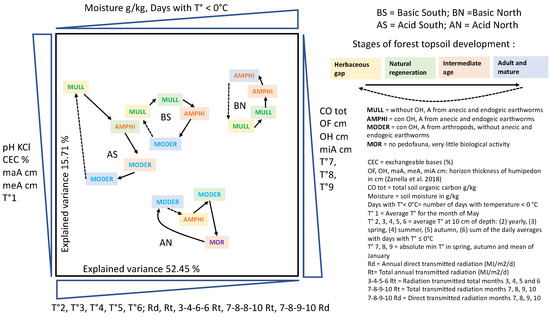
Figure 12.
Humus systems in the development stages of an uneven spruce forest in acidic environments, facing south (AS) or north (AN), or in a basic environment facing south (BS) or north (BN). Notice how the humus system changes cyclically. In the Amphi and Mull systems, there are earthworms (with A horizons similar to those of the home garden); in the other systems, the earthworms are replaced with enchytraeids and arthropods, which form much more organic horizons, similar to those of shredded tobacco. The variance explained by the model presented on the plane of two axes (whose principal components are listed with increasing or decreasing importance along the axis) is about 68%.
The four stages of a forest can be clearly seen in the yellow–green–orange–blue sequence in Figure 11. All the data used in the analysis are summarized in Table S1, which is available in the Supplementary Materials. In the upper right corner of the PCA plot, we have the northern (BN) and southern (BS) basic spruce forests, in contrast to the AN and AS acidic ones in the lower left corner. The basic ones would have higher pH, % of exchangeable bases, thickness of A horizons and average temperature in May (y-axis on the left). On the other hand, the acidic north environments show decidedly higher values of CO, thicknesses of the organic horizons and miA horizons, and absolute minimum temperatures in January and in the spring and fall (y-axis on the right). On the left of the x-axis, high values for the average temperature in the first 10 cm of soil are observed in all seasons, corresponding to both acidic and basic southern exposures. Interestingly, and probably true, is the pH compensation with AS versus AN exposure, with a soil cycling becoming similar to that encountered in BS. When this does not happen and the climatic conditions are harsh (north exposure in both cases), the two phytocoenoses separate on the basis of the parent rock, and the soil cycle that takes place in the BN is very different from that in the AN (absence of Mull and presence of Mor).
An important consequence of this diagnosis, i.e., the fact that the forest floor has a life cycle linked to that of the aerial part of the forest, is that it must be taken into account in the management and felling plans. The soil cycle must also be respected. If the ground is a bank, and if for 100–200 years, the aerial part has been borrowing energy and minerals from the ground, then it is imperative that this loan is repaid with interest to the soil before spending continues. A first management guideline could concern not only respect for some monumental trees [104] and habitat trees [21,105] but also a decisive lengthening of the life of forest trees using a doubling the duration of the cycles currently practiced. It is very probable that old age trees mainly nourish the soil, preparing it for renewal [106,107] (Figure 9).
6. Conclusions on the Importance of Humipedon in the Sylvogenic Cycle of the Forest
It is necessary to preserve and feed the Humipedon to keep the forest healthy. Theoretically, this would mean returning to the forest a quantity of organic matter equal to that exported with the forest management plan. Since the raw material wood represents an irreplaceable asset, it is necessary to define the part of the annual woody biomass increment that should be returned with the awareness that in doing so, we are impoverishing even the soil system. Trees such as spruce can live 300–400 years or more if they are not cut down. Considering that spruce trees can be removed after 100–200 years, this means reducing their life expectancy and activity in the forest by half. For the soil cycle, this means losing all the return on the investment that was made in the aerial part of the forest. We know little about what happens in the soil during this second part of the cycle. The relationships between the trees and the living things in the soil change with old age. We know that this food web changes over time because the form or the system in which Humipedon is classified changes. We know that this evolution favors the reconstitution of the soil and the natural renewal of the forest. Missing this stage could damage the forest in the long run, just as soils were depleted with intensive post-World War II agriculture.
It is necessary to respect the soil in harmony with the observance of the rights of a living forest ecosystem. This means considering the functioning of the forest at the level of all phases of its cyclical development, which follow one another in the long term from renewal to senescence.
Finally, it is essential to strengthen research and disseminate knowledge on the functioning of forest soils. Figure 13 shows a green earthworm, and in Italian, it is said that “green is hope”.
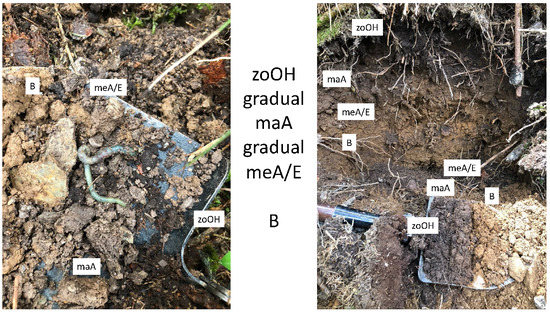
Figure 13.
(Left): Allolobophora smaragdina in the organo-mineral horizon of a Bipolar Amphi (Dysmoder t->Mull) in a mixed fir forest in the Parco dei Sogni (Dream Park), Lorenzago di Cadore (Belluno). Foresters told us that Karol Józef Wojtyła (a Polish Catholic pope) came to walk and meditate in this park, and this is the reason why earthworms have a hopeful green color in these woods. It could also be that they are green because they follow humans [85] and they too want to change their fashion every now and then. (Right): The Humipedon in which this earthworm was found. It was resting between the OH and A horizons, where it was likely turning a Dysmoder (with thick OH and A/E horizons) into an Amphi (still with a Moder zoogenic zoOH, but with a new biomacrostructured maA typical of a becoming Mull). The mineral horizon B of Copedon is distinguished from the overlying meA/E or maA by the ocher color due to the iron oxides and by the non-biological and more angular structure. Moder developed under the homogeneous population of Picea abies, while the Amphi makes its way in the more open areas of this same forest with the entry of deciduous trees (Fagus sylvatica, Acer pseudoplatanus).
Supplementary Materials
The following supporting information can be downloaded at: https://www.mdpi.com/article/10.3390/ijpb14030045/s1, Table S1: Table_Data_PCA (Zampedri 2005).
Author Contributions
Conceptualization, A.Z. and N.B.; methodology, A.Z. and R.Z.; software, R.Z.; validation, R.Z., A.Z., N.B. and J.-F.P.; formal analysis, R.Z. and A.Z.; investigation, R.Z., A.Z., N.B., F.V., G.M. and G.Z.; resources, A.Z. and N.B.; data curation, R.Z. and A.Z.; writing—original draft preparation, A.Z.; writing—review and editing, A.Z., N.B., R.G., P.M., C.M., F.V., G.M., G.Z., S.C., A.B. and J.-F.P.; visualization, A.Z., R.Z., N.B. and G.Z.; supervision, A.Z.; project administration, A.Z.; funding acquisition, A.Z., N.B. and R.Z. All authors have read and agreed to the published version of the manuscript.
Funding
This research was funded by the PROVINCE OF TRENTO (Italy) and the EUROPEAN COMMUNITY (d.d. 437 and 1159, 08/03/2002 and 25/05/2002). Work in Grand-Follié forest (Savoy, France) was supported by the endowment fund: Museum for the Planet—Sainte-Foy-Tarentaise fund. Coordination and writing were carried out in the context of ordinary funding for the research of the University of Padua for Augusto Zanella.
Institutional Review Board Statement
Ethical review and approval were waived for this study. Data were collected and studied in 2002–2005 in accordance with the Declaration of Helsinki. The TESAF (University of Padua) department’s current Ethics Committee does not pass judgment on past research.
Informed Consent Statement
Not applicable.
Data Availability Statement
The PCA data are available here: https://we.tl/t-tNktY9ZT0N, accessed on 24 June 2023. For any explanation and additional information, please send a written request to Augusto Zanella (augusto.zanella @unipd.it) or Roberto Zampedri (roberto.zampedri@fmach.it).
Acknowledgments
This work is dedicated to the Dinamus team from Trento (Italy) and of Humusica, for a living soil.
Conflicts of Interest
The authors declare no conflict of interest.
References
- Pavlis, R. Humus Does Not Exist—Says New Study. 2016. Available online: https://www.gardenmyths.com/humus-does-not-exist-says-new-study/ (accessed on 24 June 2023).
- Jenny, H. Alcohol or Humus? Science 1980, 209, 444. [Google Scholar] [CrossRef] [PubMed]
- Kopnina, H.; Washington, H.; Taylor, B.; J Piccolo, J. Anthropocentrism: More than Just a Misunderstood Problem. J. Agric. Environ. Ethics 2018, 31, 109–127. [Google Scholar] [CrossRef]
- Drosos, M.; Nebbioso, A.; Piccolo, A. Humeomics: A key to unravel the humusic pentagram. Appl. Soil Ecol. 2018, 123, 513–516. [Google Scholar] [CrossRef]
- Orwin, K.H.; Dickie, I.A.; Wood, J.R.; Bonner, K.I.; Holdaway, R.J. Soil microbial community structure explains the resistance of respiration to a dry–rewet cycle, but not soil functioning under static conditions. Funct. Ecol. 2016, 30, 1430–1439. [Google Scholar] [CrossRef]
- Zanella, A.; Ponge, J.-F.; Jabiol, B.; Van Delft, B.; De Waal, R.; Katzensteiner, K.; Kolb, E.; Bernier, N.; Mei, G.; Blouin, M.; et al. A Standardized Morpho-Functional Classification of the Planet’s Humipedons. Soil Syst. 2022, 6, 59. [Google Scholar] [CrossRef]
- Gobat, J.-M.; Guenat, C. Sols et Paysages—Types de Sols, Fonctions et Usages en Europe Moyenne, 1st ed.; Science et ingénierie de l’environnement; EPFL Press: Lausanne, Switzerland, 2019; p. 576. [Google Scholar]
- Zanella, A.; Berg, B.; Ponge, J.-F.; Kemmers, R.H. Humusica 1, article 2: Essential bases—Functional considerations. Appl. Soil Ecol. 2018, 122, 22–41. [Google Scholar] [CrossRef]
- Brandolese, A. Studio Preliminare di Suoli di Cengia. Esempi di Forme di Humus su Roccia Madre Acida—Preliminary Study of Ledge Soils. Examples of Humus Forms on Acid Parent Material; Prova finale di Laurea triennale in Tecnologie Forestali e Ambientali; Università degli Studi di Padova: Padova, Italy, 2020; pp. 1–40. [Google Scholar]
- Carollo, S. Studio Preliminare di Suoli di Cengia. Esempi di Forme di Humus su Roccia Madre Basica—Preliminary Study of Ledge Soils. Examples of Humus Forms on Basic Parent Material; Prova finale di Laurea triennale in Tecnologie Forestali e Ambientali; Università degli Studi di Padova: Padova, Italy, 2020; pp. 1–62. [Google Scholar]
- Artz, R.; Anastasiou, D.; Arrouays, D.D.; Bastos, A.C.; Bendetti, A.; Bispo, A.; Brandmayr, P.; Broll, G.; Bunning, S.; Castracani, C.; et al. European Atlas of Soil Biodiversity; European Commission: Ispra, Italy, 2010; pp. 1–136. [Google Scholar]
- Geisen, S.; Briones, M.J.I.; Gan, H.; Behan-Pelletier, V.M.; Friman, V.-P.; de Groot, G.A.; Hannula, S.E.; Lindo, Z.; Philippot, L.; Tiunov, A.V.; et al. A methodological framework to embrace soil biodiversity. Soil Biol. Biochem. 2019, 136, 107536. [Google Scholar] [CrossRef]
- Bach, E.M.; Ramirez, K.S.; Fraser, T.D.; Wall, D.H. Soil Biodiversity Integrates Solutions for a Sustainable Future. Sustainability 2020, 12, 2662. [Google Scholar] [CrossRef]
- Delgado-Baquerizo, M.; Oliverio, A.M.; Brewer, T.E.; Benavent-González, A.; Eldridge, D.J.; Bardgett, R.D.; Maestre, F.T.; Singh, B.K.; Fierer, N. A global atlas of the dominant bacteria found in soil. Science 2018, 359, 320–325. [Google Scholar] [CrossRef]
- Zanella, A.; Ponge, J.-F.; Andreetta, A.; Aubert, M.; Bernier, N.; Bonifacio, E.; Bonneval, K.; Bolzonella, C.; Chertov, O.; De Nobili, M.; et al. Forest Biodiversity, Soil Functions and Human Behavior—A Case Study. The October 29, 2018 Catastrophe in Italian Alps. Available online: https://hal.archives-ouvertes.fr/hal-02342793 (accessed on 24 June 2023).
- Rees, M. Delayed Germination of Seeds: A Look at the Effects of Adult Longevity, the Timing of Reproduction, and Population Age/Stage Structure. Am. Nat. 1994, 144, 43–64. [Google Scholar] [CrossRef]
- Fenner, M.; Thompson, K. The Ecology of Seeds; Cambridge University Press: Cambridge, UK, 2005; pp. 1–260. [Google Scholar]
- Miller, S.L.; Urey, H.C. Organic Compound Synthes on the Primitive Earth. Science 1959, 130, 245–251. Available online: http://science.sciencemag.org/content/130/3370/245.abstract (accessed on 24 June 2023). [CrossRef] [PubMed]
- Wamelink, G.W.W.; Frissel, J.Y.; Krijnen, W.H.J.; Verwoert, M.R.; Goedhart, P.W. Can plants grow on mars and the moon: A growth experiment on mars and moon soil simulants. PLoS ONE 2014, 9, e103138. [Google Scholar] [CrossRef] [PubMed]
- Ponge, J.-F. The soil as an ecosystem. Biol. Fertil. Soils 2015, 51, 645–648. [Google Scholar] [CrossRef]
- Filotas, E.; Parrott, L.; Burton, P.J.; Chazdon, R.L.; Coates, K.D.; Coll, L.; Haeussler, S.; Martin, K.; Nocentini, S.; Puettmann, K.J.; et al. Viewing forests through the lens of complex systems science. Ecosphere 2014, 5, art1. [Google Scholar] [CrossRef]
- Edwards, C.A.; Arancon, N.Q. The Influence of Environmental Factors on Earthworms; Springer: New York, NY, USA, 2022; pp. 191–232. [Google Scholar] [CrossRef]
- Richardson, D.R.; Snyder, B.A.; Hendrix, P.F. Soil Moisture and Temperature: Tolerances and Optima for a Non-native Earthworm Species, Amynthas agrestis (Oligochaeta: Opisthopora: Megascolecidae). Southeast. Nat. 2009, 8, 325–334. [Google Scholar] [CrossRef]
- Edwards, C.A.; Arancon, N.Q. Biology and Ecology of Earthworms; Springer: New York, NY, USA, 2022; p. XVI-567. Available online: https://link.springer.com/book/10.1007/978-0-387-74943-3?source=shoppingads&locale=en-it&gclid=EAIaIQobChMI5c7HnOiF_wIVKhGLCh1WnQVJEAQYASABEgLRq_D_BwE#toc (accessed on 24 June 2023).
- Darwin, C. The Formation of Vegetable Mould through the Action of Worms, with Observations on Their Habits; John Murray: London, UK, 1881; p. 326. [Google Scholar]
- Müller, P.E. Recherches sur les formes naturelles de l’humus et leur influence sur la végétation et le sol (traduit de l’allemend par Henry Grandeau). In Studien über die natürlichen Humusformen und deren Einwirkung auf Vegetation und Boden; Springer: Berlin, Germany, 1887. [Google Scholar]
- Jenny, H. The Soil Resource, Origin and Behaviour; Springer: New York, NY, USA, 1980. [Google Scholar]
- Jenny, H. Factors of Soil Formation: A System of Quantitative Pedology; Dover Publications Inc.: New York, NY, USA, 1941; p. 320. [Google Scholar]
- Staff, S.S. Illustrated Guide to Soil Taxanomy, Version 2; U.S. Department of Agriculture, Natural Resources Conservation Service, National Soil Survey Center: Lincoln, NE, USA, 2015; pp. 1–552. Available online: https://www.nrcs.usda.gov/wps/portal/nrcs/detail/soils/survey/class/taxonomy/?cid=nrcs142p2_053580 (accessed on 24 June 2023).
- Dokuchaev, V.V. Zones Verticales des Sols, Zones Agricoles, Sols du Caucase. Collection Pédologique, Exposition Universelle, Ed.; Ministère des Finances: St Petersburg, Russia, 1900; p. 56. [Google Scholar]
- IUSS Working Group WRB. World Reference Base for Soil Resources—International Soil Classification System for Naming Soils and Creating Legends for Soil Maps, 4th ed.; IUSS—International Union of Soil Sciences: Vienna, Austria, 2022; p. 236. [Google Scholar]
- Blum, W.; Schad, P.; Nortclif, S. Essentials of Soil Science Soil Formation, Functions, Use and Classification (World Reference Base, WRB); Gebr. Borntraeger Science Publishers: Stuttgart, Germany, 2018; p. 171. [Google Scholar]
- Yigini, Y.; Panagos, P. Assessment of soil organic carbon stocks under future climate and land cover changes in Europe. Sci. Total Environ. 2016, 557, 838–850. [Google Scholar] [CrossRef]
- Bünemann, E.K.; Bongiorno, G.; Bai, Z.; Creamer, R.E.; De Deyn, G.; de Goede, R.; Fleskens, L.; Geissen, V.; Kuyper, T.W.; Mäder, P.; et al. Soil quality—A critical review. Soil Biol. Biochem. 2018, 120, 105–125. [Google Scholar] [CrossRef]
- Montanarella, L.; Panagos, P. The relevance of sustainable soil management within the European Green Deal. Land Use Policy 2021, 100, 104950. [Google Scholar] [CrossRef]
- Pelosi, C.; Barot, S.; Capowiez, Y.; Hedde, M.; Vandenbulcke, F. Pesticides and earthworms. A review. Agron. Sustain. Dev. 2014, 34, 199–228. [Google Scholar] [CrossRef]
- Beketov, M.A.; Kefford, B.J.; Schafer, R.B.; Liess, M. Pesticides reduce regional biodiversity of stream invertebrates. Proc. Natl. Acad. Sci. USA 2013, 110, 11039–11043. [Google Scholar] [CrossRef]
- Fusaro, S.; Squartini, A.; Paoletti, M.G. Functional biodiversity, environmental sustainability and crop nutritional properties: A case study of horticultural crops in north-eastern Italy. Appl. Soil Ecol. 2018, 123, 699–708. [Google Scholar] [CrossRef]
- Aszalós, R.; Thom, D.; Aakala, T.; Angelstam, P.; Brūmelis, G.; Gálhidy, L.; Gratzer, G.; Hlásny, T.; Katzensteiner, K.; Kovács, B.; et al. Natural disturbance regimes as a guide for sustainable forest management in Europe. Ecol. Appl. 2022, 32, e2596. [Google Scholar] [CrossRef] [PubMed]
- Motta, R.; Ascoli, D.; Corona, P.; Marchetti, M.; Vacchiano, G. Silviculture and wind damages. The storm “Vaia”. Forest@—Riv. Selvic. Ecol. For. 2018, 15, 94–98. [Google Scholar] [CrossRef]
- Zanella, A.; Ponge, J.-F.; Gobat, J.-M.; Juilleret, J.; Blouin, M.; Aubert, M.; Chertov, O.; Rubio, J.L. Humusica 1, article 1: Essential bases—Vocabulary. Appl. Soil Ecol. 2018, 122, 10–21. [Google Scholar] [CrossRef]
- Gobat, J.M.; Aragno, M.; Matthey, W. The Living Soil: Fundamentals of Soil Science and Soil Biology; Science Publishers: Boca Raton, FL, USA, 2004; p. 626. [Google Scholar]
- Ponge, J.-F. Emergent properties from organisms to ecosystems: Towards a realistic approach. Biol. Rev. 2005, 80, 403–411. [Google Scholar] [CrossRef] [PubMed]
- Lavelle, P. Ecology and the challenge of a multifunctional use of soil. Pesqui. Agropecuària Bras. 2009, 44, 803–810. Available online: http://www.scielo.br/scielo.php?script=sci_arttext&pid=S0100-204X2009000800003&nrm=iso (accessed on 24 June 2023). [CrossRef]
- Allen, C.R.; Angeler, D.G.; Garmestani, A.S.; Gunderson, L.H.; Holling, C.S. Panarchy: Theory and Application. Ecosystems 2014, 17, 578–589. [Google Scholar] [CrossRef]
- Moragues-Quiroga, C.; Juilleret, J.; Gourdol, L.; Pelt, E.; Perrone, T.; Aubert, A.; Morvan, G.; Chabaux, F.; Legout, A.; Stille, P.; et al. Genesis and evolution of regoliths: Evidence from trace and major elements and Sr-Nd-Pb-U isotopes. Catena 2017, 149, 185–198. [Google Scholar] [CrossRef]
- Parisi, V.; Menta, C.; Gardi, C.; Jacomini, C.; Mozzanica, E. Microarthropod communities as a tool to assess soil quality and biodiversity: A new approach in Italy. Agric. Ecosyst. Environ. 2005, 105, 323–333. [Google Scholar] [CrossRef]
- Menta, C.; Conti, F.D.; Pinto, S. Microarthropods biodiversity in natural, seminatural and cultivated soils—QBS-ar approach. Appl. Soil Ecol. 2018, 123, 740–743. [Google Scholar] [CrossRef]
- Van Eekeren, N.; Bommelé, L.; Bloem, J.; Schouten, T.; Rutgers, M.; de Goede, R.; Reheul, D.; Brussaard, L. Soil biological quality after 36 years of ley-arable cropping, permanent grassland and permanent arable cropping. Appl. Soil Ecol. 2008, 40, 432–446. [Google Scholar] [CrossRef]
- Yin, R.; Kardol, P.; Thakur, M.P.; Gruss, I.; Wu, G.-L.; Eisenhauer, N.; Schädler, M. Soil functional biodiversity and biological quality under threat: Intensive land use outweighs climate change. Soil Biol. Biochem. 2020, 147, 107847. [Google Scholar] [CrossRef] [PubMed]
- Kopittke, P.M.; Dalal, R.C.; Hoeschen, C.; Li, C.; Menzies, N.W.; Mueller, C.W. Soil organic matter is stabilized by organo-mineral associations through two key processes: The role of the carbon to nitrogen ratio. Geoderma 2020, 357, 113974. [Google Scholar] [CrossRef]
- FAO. Technical Specifications and Country Guidelines for Global Soil Organic Carbon Sequestration Potential Map GSOCseq; FAO: Rome, Italy, 2020; pp. 1–34. Available online: http://www.fao.org/3/cb0353en/cb0353en.pdf (accessed on 24 June 2023).
- Yang, Y.; Dou, Y.; An, S. Testing association between soil bacterial diversity and soil carbon storage on the Loess Plateau. Sci. Total Environ. 2018, 626, 48–58. [Google Scholar] [CrossRef]
- Melland, A.R.; Antille, D.L.; Dang, Y.P. Effects of strategic tillage on short-Term erosion, nutrient loss in runoff and greenhouse gas emissions. Soil Res. 2017, 55, 201–214. [Google Scholar] [CrossRef]
- Nath, A.J.; Rattan, L.; Lal, R. Effects of Tillage Practices and Land Use Management on Soil Aggregates and Soil Organic Carbon in the North Appalachian Region, USA (Letter to the Editor). Pedosphere 2017, 27, 172–176. [Google Scholar] [CrossRef]
- Loaiza Puerta, V.; Pujol Pereira, E.I.; Wittwer, R.; van der Heijden, M.; Six, J. Improvement of soil structure through organic crop management, conservation tillage and grass-clover ley. Soil Tillage Res. 2018, 180, 1–9. [Google Scholar] [CrossRef]
- Rieke, E.L.; Cappellazzi, S.B.; Cope, M.; Liptzin, D.; Mac Bean, G.; Greub, K.L.H.; Norris, C.E.; Tracy, P.W.; Aberle, E.; Ashworth, A.; et al. Linking soil microbial community structure to potential carbon mineralization: A continental scale assessment of reduced tillage. Soil Biol. Biochem. 2022, 168, 108618. [Google Scholar] [CrossRef]
- Bernier, N. Hotspots of biodiversity in the underground: A matter of humus form? Appl. Soil Ecol. 2018, 123, 305–312. [Google Scholar] [CrossRef]
- Ponge, J.F.; André, J.; Bernier, N.; Gallet, C. La régénération naturelle: Connaissances actuelles. le cas de l’épicéa en forêt de Macot (Savoie). Rev. For. Française 1994, 46, 25–45. [Google Scholar] [CrossRef]
- Bernier, N. Earthworm feeding activity and development of the humus profile. Biol. Fertil. Soils 1998, 26, 215–223. [Google Scholar] [CrossRef]
- Barois, I. Mucus production and microbial activity in the gut of two species of amynthas (megascolecidae) from cold and warm tropical climates. Soil Biol. Biochem. 1992, 24, 1507–1510. [Google Scholar] [CrossRef]
- Barois, I.; Villemin, G.; Lavelle, P.; Toutain, F. Transformation of the soil structure through Pontoscolex corethrurus (Oligochaeta) intestinal tract. Geoderma 1993, 56, 57–66. [Google Scholar] [CrossRef]
- André, J.; Gensac, P.; Pellissier, F.; Trosset, L. Régénération des peuplements d’épicéa en altitude: Recherches préliminaires sur le rôle de l’allélopathie et de la mycorhization dans les premiers stades du développement. Rev. D’écologie Biol. Du Sol 1987, 24, 301–310. [Google Scholar]
- André, J.; Gauthier, P.; Gensac, M. La Régénération dans la pessière à myrtille: Description préliminaire de deux stations dans les Alpes septentrionales internes. Bull. D’ecologie 1990, 21, 51–61. [Google Scholar]
- Bernier, N.; André, J. Dynamique de la biodiversité en milieu subalpin: Exemple de diversité des processus et gestion de l’espace en moyenne vallée de Tarentaise (Savoie, France): {Biodiversity dynamics at the subalpine level: A case study of processes diversity and land manag. Ecologie 1998, 29, 547–555. Available online: https://www.researchgate.net/publication/233902840_Dynamique_de_la_biodiversite_en_milieu_subalpin_exemple_de_diversite_des_processus_et_gestion_de_l%27espace_en_moyenne_vallee_de_Tarentaise_Savoie_France_Biodiversity_dynamics_at_the_subalpine_level_a_c (accessed on 24 June 2023).
- Riera, B. Importance des buttes de déracinement dans la régénération forestière en Guyane française. Revue d’Écologie 1985, 40, 321–329. [Google Scholar] [CrossRef]
- Brown, J.L. Étude de la perturbation des horizons du sol par un arbre qui se renverse et de son impact sur la pédogenèse. Can. J. Soil Sci. 1977, 57, 173–186. [Google Scholar] [CrossRef]
- Romell, L.G. An Example of Myriapods as Mull Formers. Ecology 1935, 16, 67–71. [Google Scholar] [CrossRef]
- Zackrisson, O.; Bernier, N.; Nilsson, M.-C.; Gallet, C. The Forest Regeneration Puzzle. BioScience 1998, 48, 523–530. [Google Scholar] [CrossRef]
- Van der Meer, P.J.; Bongers, F. Patterns of Tree-Fall and Branch-Fall in a Tropical Rain Forest in French Guiana. J. Ecol. 1996, 84, 19–29. [Google Scholar] [CrossRef]
- Galvan, P.; Ponge, J.-F.J.F.; Chersich, S.; Zanella, A. Humus Components and Soil Biogenic Structures in Norway Spruce Ecosystems. Soil Sci. Soc. Am. J. 2008, 72, 548–557. [Google Scholar] [CrossRef]
- Bernier, N.; Ponge, J.F. Humus form dynamics during the sylvogenetic cycle in a mountain spruce forest. Soil Biol. Biochem. 1994, 26, 183–220. [Google Scholar] [CrossRef]
- Zanella, A.; Tomasi, M.; Cesare, D.S.; Frizzera, L.; Jabiol, B.; Nicolini, G.; Sartori, G.; Calabrese, M.S.; Manacabelli, A.; Nardi, S.; et al. Humus Forestali—Manuale di ecologia per il riconoscimento e l’interpretazione—Applicazione alle faggete; Centro Ecologia Alpina, Fondazione Edmund Mach: San Michele all’Adige, Italy, 2001; p. 320. [Google Scholar]
- De Nicola, C.; Zanella, A.; Testi, A.; Fanelli, G.; Pignatti, S. Humus forms in a Mediterranean area (Castelporziano Reserve, Rome, Italy): Classification, functioning and organic carbon storage. Geoderma 2014, 235, 90–99. [Google Scholar] [CrossRef]
- Andreetta, A.; Cecchini, G.; Bonifacio, E.; Comolli, R.; Vingiani, S.; Carnicelli, S. Tree or soil? Factors influencing humus form differentiation in Italian forests. Geoderma 2016, 264, 195–204. [Google Scholar] [CrossRef]
- Mori, K.; Bernier, N.; Kosaki, T.; Ponge, J.-F. Tree influence on soil biological activity: What can be inferred from the optical examination of humus profiles? Eur. J. Soil Biol. 2009, 45, 290–300. [Google Scholar] [CrossRef]
- Ponge, J.F.; Delhaye, L. The heterogeneity of humus profiles and earthworm communities in a virgin beech forest. Biol. Fertil. Soils 1995, 20, 24–32. [Google Scholar] [CrossRef]
- Motta, R.; Berretti, R.; Lingua, E.; Piussi, P. Coarse woody debris, forest structure and regeneration in the Valbona Forest Reserve, Paneveggio, Italian Alps. For. Ecol. Manag. 2006, 235, 155–163. [Google Scholar] [CrossRef]
- Bernier, N. Fonctionnement biologique des humus et dynamique des pessières alpines. Le cas de la forêt de Macot-La-Plagne (Savoie). [Humus biological organization and alpine spruce forest dynamics. The example of Macot-La-Plagne forest (Savoie, France)]. Ecologie 1997, 28, 23–44. [Google Scholar]
- McFee, W.W.; Stone, E.L. The Persistence of Decaying Wood in the Humus Layers of Northern Forests. Soil Sci. Soc. Am. J. 1966, 30, 513–516. [Google Scholar] [CrossRef]
- Zanella, A.; Ponge, J.-F.; Fritz, I.; Pietrasiak, N.; Matteodo, M.; Nadporozhskaya, M.; Juilleret, J.; Tatti, D.; Le Bayon, R.-C.; Rothschild, L.; et al. Humusica 2, article 13: Para humus systems and forms. Appl. Soil Ecol. 2018, 122, 181–199. [Google Scholar] [CrossRef]
- Tatti, D.; Fatton, V.; Sartori, L.; Gobat, J.-M.; Le Bayon, R.-C. What does ‘lignoform’ really mean? Appl. Soil Ecol. 2018, 123, 632–645. [Google Scholar] [CrossRef]
- Mayer, M.; Rosinger, C.; Gorfer, M.; Berger, H.; Deltedesco, E.; Bässler, C.; Müller, J.; Seifert, L.; Rewald, B.; Godbold, D.L. Surviving trees and deadwood moderate changes in soil fungal communities and associated functioning after natural forest disturbance and salvage logging. Soil Biol. Biochem. 2022, 166, 108558. [Google Scholar] [CrossRef]
- Stutz, K.P.; Lang, F. Forest ecosystems create pedogenic patchworks through woody debris, trees, and disturbance. Geoderma 2023, 429, 116246. [Google Scholar] [CrossRef]
- Bouché, M. Des vers de Terre et des Hommes. Découvrir nos Ecosystèmes Fonctionnant à L’énergie Solaire; Acte Sud Nature: Paris, France, 2014; p. 336. [Google Scholar]
- Selosse, M.-A. Jamais Seul—Ces Microbes qui Construisent les Plantes, les Animaux et les Civilisations; Actes Sud: Arles, France, 2017; p. 352. [Google Scholar]
- Lovelock, J.E. Hands up for the Gaia hypothesis. Nature 1990, 344, 100–102. [Google Scholar] [CrossRef]
- Banerjee, S.; Walder, F.; Büchi, L.; Meyer, M.; Held, A.Y.; Gattinger, A.; Keller, T.; Charles, R.; van der Heijden, M.G.A. Agricultural intensification reduces microbial network complexity and the abundance of keystone taxa in roots. ISME J. 2019, 13, 1722–1736. [Google Scholar] [CrossRef]
- Fierer, N. Embracing the unknown: Disentangling the complexities of the soil microbiome. Nat. Rev. Microbiol. 2017, 15, 579–590. [Google Scholar] [CrossRef]
- Wagg, C.; Schlaeppi, K.; Banerjee, S.; Kuramae, E.E.; van der Heijden, M.G.A. Fungal-bacterial diversity and microbiome complexity predict ecosystem functioning. Nat. Commun. 2019, 10, 4841. [Google Scholar] [CrossRef]
- Wang, Z.; Feng, B.; Zhang, D.; Ghosh, S.; Pan, B.; Xing, B. Role of NOM–hematite nanoparticle complexes and organic and inorganic cations in the coherence of silica and clay particles: Evaluation based on nanoscale forces and molecular self-assembly. Environ. Sci. Nano 2021, 8, 822–836. [Google Scholar] [CrossRef]
- Mahmoodi, K.; West, B.J.; Grigolini, P. Self-organizing Complex Networks: Individual versus global rules. Front. Physiol. 2017, 8, 478. [Google Scholar] [CrossRef]
- Feng, W.; Plante, A.F.; Aufdenkampe, A.K.; Six, J. Soil organic matter stability in organo-mineral complexes as a function of increasing C loading. Soil Biol. Biochem. 2014, 69, 398–405. [Google Scholar] [CrossRef]
- Zanella, A.; Ponge, J.-F.; Jabiol, B.; Sartori, G.; Kolb, E.; Le Bayon, R.-C.; Gobat, J.-M.; Aubert, M.; De Waal, R.; Van Delft, B.; et al. Humusica 1, article 5: Terrestrial humus systems and forms—Keys of classification of humus systems and forms. Appl. Soil Ecol. 2018, 122, 75–86. [Google Scholar] [CrossRef]
- Giannini, R.; Susmel, L. Forests, woods, forest plantations. Forest@—Riv. Selvic. Ecol. For. 2006, 3, 464–487. [Google Scholar] [CrossRef]
- Oldeman, R.A.A. Forests: Elements of Silvology; Springer: Berlin/Heidelberg, Germany, 2012; p. 624. [Google Scholar] [CrossRef]
- Thompson, L.R.; Sanders, J.G.; McDonald, D.; Amir, A.; Ladau, J.; Locey, K.J.; Prill, R.J.; Tripathi, A.; Gibbons, S.M.; Ackermann, G.; et al. A communal catalogue reveals Earth’s multiscale microbial diversity. Nature 2017, 551, 457–463. [Google Scholar] [CrossRef]
- Bahram, M.; Hildebrand, F.; Forslund, S.K.; Anderson, J.L.; Soudzilovskaia, N.A.; Bodegom, P.M.; Bengtsson-Palme, J.; Anslan, S.; Coelho, L.P.; Harend, H.; et al. Structure and function of the global topsoil microbiome. Nature 2018, 560, 233–237. [Google Scholar] [CrossRef]
- Zampedri, R. Relazione tra Clima, Forme di Humus e Dinamica Forestale in Ambiente di Pecceta Altimontana; Tesi di Dottorato: Padova, Italy, 2005. [Google Scholar]
- Ponge, J.-F. Plant–soil feedbacks mediated by humus forms: A review. Soil Biol. Biochem. 2013, 57, 1048–1060. [Google Scholar] [CrossRef]
- Motta, R.; Brang, P.; Frehner, M.; Ott, E. Copertura muscinale e rinnovazione di abete rosso (Picea abies L.) nella pecceta subalpina di Sedrum (Grigioni, Svizzera). Monti E Boschi 1994, 3, 49–56. [Google Scholar]
- Baier, R.; Ettl, R.; Hahn, C.; Göttlein, A. Early development and nutrition of Norway spruce (Picea abies (L.) Karst.) seedlings on different seedbeds in the Bavarian limestone Alps—A bioassay. Ann. For. Sci. 2006, 63, 339–348. [Google Scholar] [CrossRef]
- Bütler, R.; Patty, L.; Le Bayon, R.-C.; Guenat, C.; Schlaepfer, R. Log decay of Picea abies in the Swiss Jura Mountains of central Europe. For. Ecol. Manag. 2007, 242, 791–799. [Google Scholar] [CrossRef]
- Susmel, L. Normalizzazione Delle Foreste Alpine: Basi Ecosistemiche, Equilibrio, Modelli Colturali, Produttività: Con Applicazione Alle Foreste del Trentino; Liviana: Padova, Italy, 1980; p. 437. [Google Scholar]
- Martin, M.; Paillet, Y.; Larrieu, L.; Kern, C.C.; Raymond, P.; Drapeau, P.; Fenton, N.J. Tree-Related Microhabitats Are Promising Yet Underused Tools for Biodiversity and Nature Conservation: A Systematic Review for International Perspectives. Front. For. Glob. Change 2022, 5, 136. [Google Scholar] [CrossRef]
- McMahen, K.; Anglin, C.D.; Lavkulich, L.M.; Grayston, S.J.; Simard, S.W. Small-volume additions of forest topsoil improve root symbiont colonization and seedling growth in mine reclamation. Appl. Soil Ecol. 2022, 180, 104622. [Google Scholar] [CrossRef]
- Wohlleben, P. The Hidden Life of Trees: What They Feel, How They Communicate—Discoveries from a Secret World; Greystone Books: Vancouver, Canada, 2016; p. 288. [Google Scholar]
Disclaimer/Publisher’s Note: The statements, opinions and data contained in all publications are solely those of the individual author(s) and contributor(s) and not of MDPI and/or the editor(s). MDPI and/or the editor(s) disclaim responsibility for any injury to people or property resulting from any ideas, methods, instructions or products referred to in the content. |
© 2023 by the authors. Licensee MDPI, Basel, Switzerland. This article is an open access article distributed under the terms and conditions of the Creative Commons Attribution (CC BY) license (https://creativecommons.org/licenses/by/4.0/).